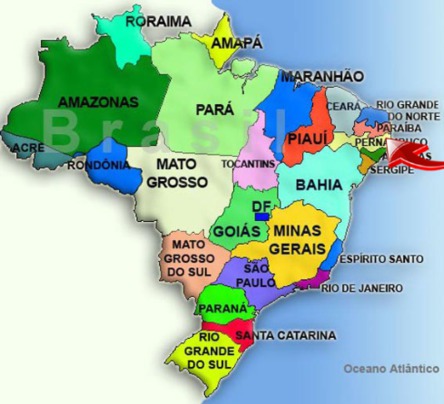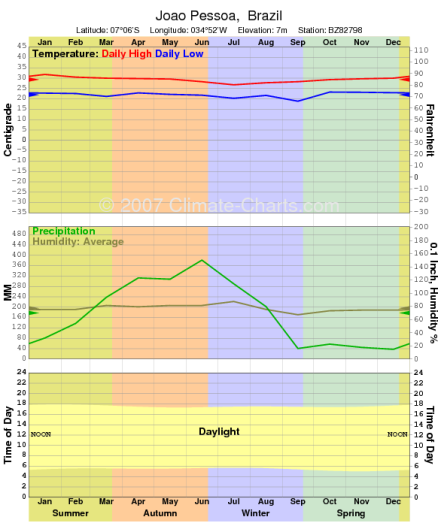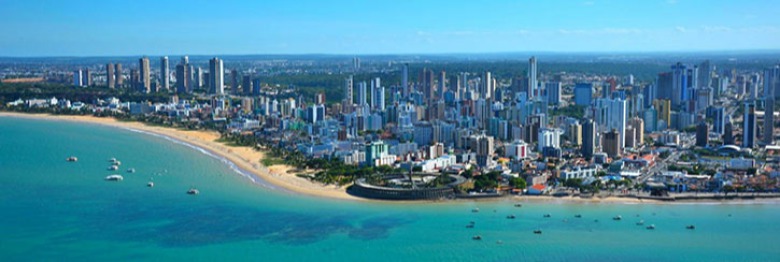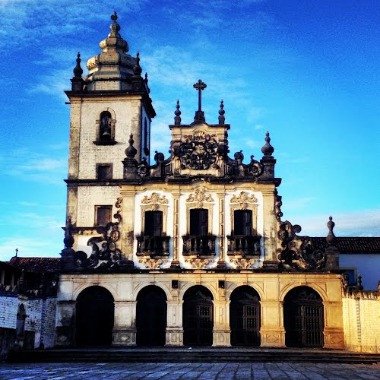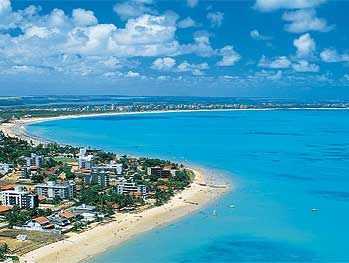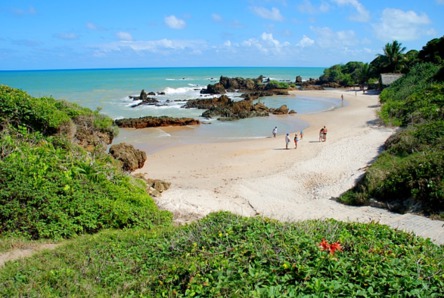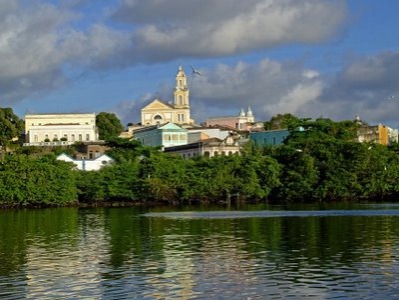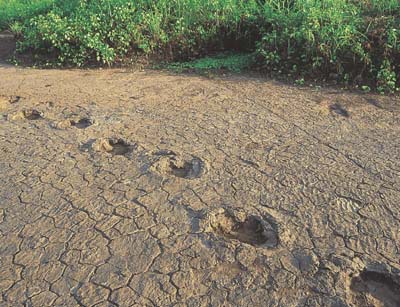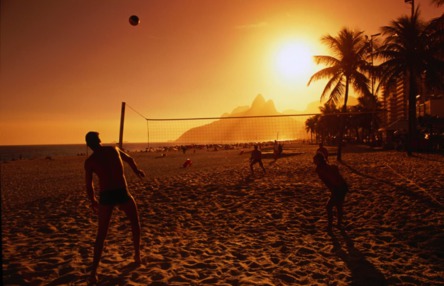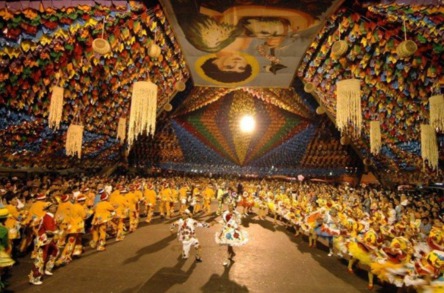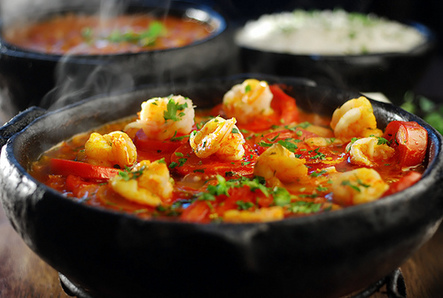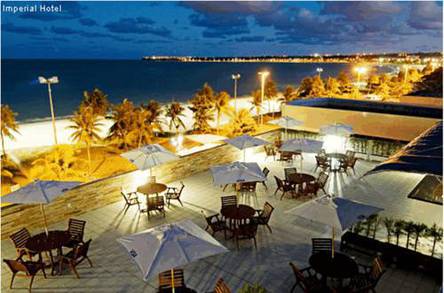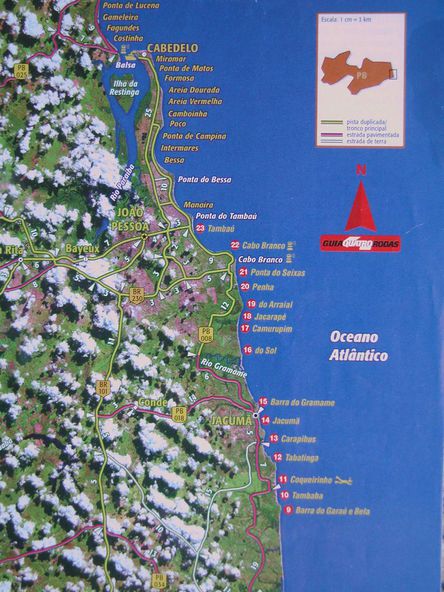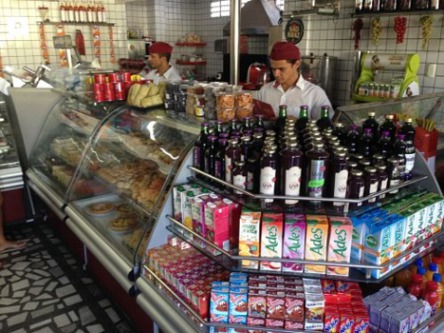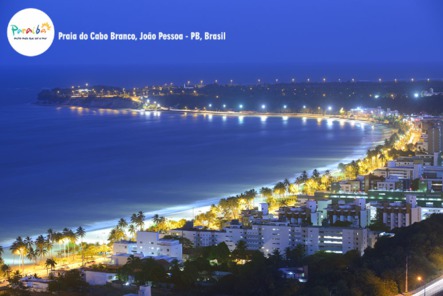Why Paraiba?
Why is Paraiba the place to invest for Brazilian Beach Living?
A General Overview of the up and coming State of Paraiba
Climate
Joao Pessoa has a tropical climate characterized by warm to hot temperatures that are consistent throughout the year. Extremes are not common in Joao Pessoa, but precipitation is common
year-round. The normal rainier season is during "winter" months from June to August.
Temperature
Joao Pessoa has a yearly average temperature of 82. The yearly average high is 87.5, with February and March having the highest average (90 degrees). Joao Pessoa averages a low of 76.5, with July and
August having the lowest average (73 degrees). November through April is the warmest period (77 to 90 degrees); May through October's temperatures range from 73 to 87 degrees.
Precipitation
In Joao Pessoa, precipitation is common and varying. The relative dry season is September through January. March through August receives much heavier amounts of rain, with June averaging the most
(9.19 inches). The rainfall averages for the rest of the months are 3.8 inches (March), 5.75 inches (April), 6.92 inches (May), 7.25 inches (July) and 4.7 inches (August).
Humidity
Humidity levels in Joao Pessoa can change drastically from one day to the next, ranging anywhere from 35 to 100 percent depending on the season. In accordance with the rainy season, May through
September has higher humidity averages (approximately 85 percent) than the rest of the year. Mid-December to February is the least humid (73 percent). During the warmer months, humidity can cause
some discomfort. ( I am rarely uncomfortable, do not enjoy high humidity).
Sunshine
November has the most hours of sunshine a day: about nine. July has the fewest: about five.
Thanks to ClimateCharts.com
The name Paraiba comes from the combination of the Tupi words pa’ra (river) anda’íba (unsuitable for navigation). But after all, is it Paraíba or paradise? It is hard to say when one takes into
consideration all theattractions of the Brazilian state located on the farthest eastern portion of the Americas: the Ponta do Seixas, on Cabo Branco beach,where, according to a traditional saying,
“the sun rises first”. Landof the sun indeed, and of an enviable shore — but also of other historical, ecological and cultural beauties.
Before it was finally taken by the Portuguese, the region was nearly
seized by the Normands. In the mid l6th century, Norman smugglers, with
the help of the Potiguara Indians, used the anchorage sites of
Cabedelo, in the Traição and Cabo Branco bays, to take the best quality
Brazil – wood from the Brazilian coast, as well as cotton and wild
animal hides. In 1585 a Portuguese settler by the name of João Tavares
joined Tabajara chief Pirajibe and managed to establish a settlement 22
km far from the mouth of the Paraíba River. The settlement was first
known as Nossa Senhora das Neves, later becoming Filipéia (in honor of
Philip II, King of both Spain and Portugal). In the following century,
during the Dutch invasion, it was named Frederikstadt, before becoming
Paraíba and finally, in 1930, João Pessoa.
The capital of the state of Paraíba is rich in historical monuments and
contemporary buildings. Among the examples of baroque-style
constructions which impress all tourists are the Church of Mercy, built
by Duarte da Silveira in 1602, which preserves its original structure;
the 1608 Church of St. Francis, with tiled walls and the floor carpeted
with antique flagstones; the Church and the Monastery of São Bento,
concluded in 1716 and built of stone blocks and limestone, masonry and
wood.
Other important historical landmarks in the state are the Fortress of
Santa Catarina (built in 1585 of limestone and whale oil), located in
Cabedelo, and the Casa da Pólvora, located in the capital, which
witnessed many struggles and invasions on the coast.
Nevertheless, the greatest enchantment comes from the sea. In addition
to the beach of Cabo Branco, with its Lighthouse belvedere, the beaches
of Tambaú, Manaíra and Bessa are among the most urbanized on thecoast,
with lukewarm waters. In Tambaü, two kilometers away
from the coast, lie the beautiful reef formations, with its natural
pools known as Picãozinho. At these beaches one finds the highest
concentration of hotels, flats, lodgings and all the infrastructure which guarantee an agreeable and cozy stay in the region.
ECOLOGICAL TOURISM
In lntermares, the Macaco Sea is a compulsory stop for surfers: its
waves are ideal, due to a natural crack in the reef chains. And the
calm waters of the Sanhauá river favor nautical tourism on the river
beach of Jacaré. Also worth highlighting is the Tambaba beach, the
first official naturism beach of the northeastern region, 40 km away
from João Pessoa, in the municipality of Conde; its waters are
bluish-green and warm, forming natural pools. There are also beautiful
20-meter high sea cliffs in the region, which also emerge,
multicolored, on the beach of Coqueirinho, next to the Tambaba beach
and almost untouched.
Other famous beaches are Jacumã, featuring the most exciting carnival on the coast of Paraíba; the Barra de Camaratuba (with stretches of deserted beach, deep waters and dunes from the
Paleolithic period); the Bay of Traição, the site of old battles; and the Barra de Mamanguape, which shelters the Center for the Preservation of the Manatee.
The World Famous Tambaba Naturist Beach area south of Jacuma
As for preservation, it is worth recalling that Paraíba is one of the
most important ecological tourist sites in the country. The state also
shelters several species of the flora and fauna that remain from the
Atlantic Forest. In João Pessoa, the 471 hectare Buraquinho Forest (the
Botanical Garden) is a true genetic base of both the animal and vegetal
life of the Northeastern region. In Cabedelo, the 530 hectare
Restinga Island, located on the estuary of the Paraíba River, several
types of ecosystems can be found: mangroves, the estuary, the Atlantic
Forest, lagoons and the forests typical of the restingas, beaches
covered by mud, which usually rise up out of the water parallel to the
coast.
In Mamanguape and Rio Tinto lies the Ecological Reserve of the
Guaribas, aimed at sheltering this endangered monkey species. Other
natural beauties are Pedra da Boca, in Araruna, a set of rocks
frequently visited by mountain climbers, and the 1197 meter high Pico
do jabre, the highest elevation in Paralba, from where the visitor can
admire the mountain forest, rivers, mineral water springs and the
caatinga, a type of stunted vegetation found in the more arid areas of
northeastern Brazil.
DINOSAURS FROM THE BRAZILIAN PRE-HISTORICAL AGE
The region is also a survey center on the Brazilian prehistorical era.
In the municipality of Sousa, 427 km away from the capital, in the
hinterland of the state, lies the famous Dinosaurs Valley, where
researchers have found the footprints of prehistorical animals, dating
back 130 million years. The area is regarded as one of the most
important archeological sites in the world – the Peixe River basin
displays the highest incidence of dinosaur footprints in the world.
In Ingá, located on the Borborema Plateau, there are cave inscriptions
engraved on stone, still an enigma to experts (some attribute the signs
to the ‘1isit of Phoenicians to Brazil). The local Museum of Natural
History holds lots of information on the animals that lived in the
region in remote eras, such as the gigantic tropical America iguana,
the armadillo, mastodons and others. Museums and cultural centers
abound in the region. In João Pessoa, the most important are the José
Lins do Rêgo Cultural Space and the Augusto dos Anjos Memorial (located
in the Literary Academy of Paraíba), featuring part of the heritage of
these great writers, and the museum and crypt of former-president
Epitácio Pessoa, located in the Court of Justice.
In the beginning of the year, sports tournaments and folkloric
festivals stir up the capital’s shoreline. In February, the feast takes
over the streets even before carnival, gathering street-dancing
merrymaker groups of frevo, maracatu, sculamba, coco and caboclinho.
Among the most famous June feasts are those of Campina Grande, the second largest city in the state, and SãoJoão da Lagoa, in the Solon de
Lucena Park. The forró is the musical rhythm typical of these
celebrations. But there are still several other types of folkloric
demonstrations, such as the incelenças (funeral chants sung in unison,
without musical instruments), the nau catarineta, popular plays on sea
themes performed in the streets, the reisaclo, held on 6th of January,
celebrating the Epiphany, the vaquejada, a round up of cattle, and the
banda cabaçal, groups of percussion and wind instruments, common in the
Brazilian northeast.
CRAFTSMANSHIP AND TYPICAL DISHES
Embroidery and lace makers, ceramists, painters and sculptors use
folkloric themes in their works. To be highlighted are the coconut
fiber items manufactured in Lagoa Seca; the banners painted in Catolé
do Rocha; artisan Antonio Paulo Freire’s coconut heads; Maria Paulina’s
ceramic items; the goods from João Miguel do Taipu; the laces and
embroideries from Picu, Umbuzeiro and São Felix; and the labyrinth”, a
type of embroidery produced in Juarez Távora.
One shouldn’t miss the delights of the cookery from Paraíba. So, be
prepared for the sun-dried meat; the sarapatel (made of sheep’s or
pig’s viscera and blood); buchadas, made of animal guts; farm chicken,
coconut tapiocas and other delights. The cuscuz, a dish made of steamed
rice, manioc or corn meal, the pamonha, a sweet made of corn paste,
rolled and baked in fresh cornhusks, and the baião-de-dois (black beans
rice and cheese cooked together) are a must, not to mention the local
sea food, such as large shrimps, crabs, squids, swordfish – accompanied
by coconut water, or a delicious cachacinha-de-cabeça, an alcoholic
drink made of sugarcane, as you relax by the sea.
At night, excitement continues in the bars and restaurants of the
capital and along the beaches of Tambaü, Cabo Branco, Manara, Bessa,
lntermares, Seixas and Penha. In the Largo da Gameleira young people
get together whereas in the so-called Baixo Tambaú, bars specialized in
popular Brazilian music, create a romantic environment under leafy
coconut trees.
Thanks to BrazilInsight.nl
The best beaches and prices are at #9-#15 above in the city and south of Jacuma, Paraiba. The State Capital is Joao Pessoa at the top of the map, about 22KM north. The beach areas north of Joao
Pessoa and south of Pitimbu are unfortunately muddied up by two large rivers emptying in to the ocean that carry silt to the beaches. They rarely clear up and get the gorgeous emerald green/blue
color because of it. The middle area between, as noted above have the best ocean quality. In all of Brazil the two areas with the most beautiful ocean are the above noted beaches and in Alagoas two
states to the south. There land prices are several times higher however.
If ocean quality is not a big deal then you can feel good most anywhere in the state depending on what your priorities are. North of Joao Pessoa and south of Pitimbu the prices are less for property
for the most part.
Natal is already long discovered and prices are much higher than in Paraiba. Bahia (Salvador north) also, as is Alagoas where we used to live. Pernambuco you want to avoid for the most part.
(violence). The hottest area with the best beaches is south of the capital city Joao Pessoa where I live. If you GoogleEarth Jacuma, Paraiba Brazil it will take you to us. There is Jacuma, next south
is Carapibus, then Tabatinga, Coqueirinho, Tambaba and Praia Bela. It is a vacation location, very undeveloped at this point. Because of this the prices are far more competitive than anywhere else in
the NEast of Brazil. If you want perfect infrastructure stay in Joao Pessoa or any of the other capital cities in the NE.
Natal and Fortaleza are in very arid areas, and windy. You get lots of sun however if you love some tropical green in the picture you won’t find it there. Natal is famous for it’s sand dunes, which
means wind, wind, wind. Prices across the board are much higher than in Paraiba as they are way ahead of the development curve, especially compared to the south coast in Jacuma.
If you want city life, Joao Pessoa is a good choice to check out. If you want really clean air, more natural beauty around, a more relaxed way of life but still be near a city, then where I live
could also be for you.
Photos of Joao Pessoa from the mayor’s website: HERE
Brazil is more now a middle class country. Many are doing very well financially. More and more Brazilians can afford to retire to beautiful beach cities like Joao Pessoa.
Surrounded by miles of beautiful beaches, the weather’s warm and sunny year-round. Roughly 75 miles from Recife and 110 miles from Natal, the city is one of the oldest in Brazil’s Northeast.
Today, this is where many Brazilians retire young, vacation and buy second homes. In particular, the city is popular as a retirement destination for senior civil servants.
That’s good news for the businesses of Joao Pessoa. As more of these wealthy retirees move here, the city’s businesses have more customers. And there’s more demand for services—like dentists and
cardiologists.
There is a SERIOUS shortage of office space in the city and it’s only going to get worse.
The city has three square miles of forest, providing a green backdrop to almost 25 miles of beach. The city’s protected forest limits development here. Cabo Branco is a prime residential area. This
exclusive neighborhood borders the boardwalk. Cabo Branco sits between the ocean and the forest, on a thin triangle of land. You’ll find the city’s nicest restaurants and boardwalk kiosks here, and
uncrowded stretches of beach.
Sitting just above Cabo Branco and on an elevated piece of land is the area of Altiplano, a high-end residential neighborhood with a mix of single family homes and luxury condos.
The municipality of Joao Pessoa recently relaxed planning regulations in Altiplano, and will now allow mixed commercial, resort and residential projects to develop here. A master plan calls for
residential development to house 40,000 people. There are also plans for hotels, shopping malls, private schools and medical services.
We are only 25 minutes south of Joao Pessoa where you have access to pretty much everything from huge shopping centers to decent restaurants and consistent beach events all year long. .
I was the third American to buy in this entire area in 05. Now there are only a handful more. There are a few Swedes, Germans, Italians, Dutch, English, Portuguese and Danish owners here as
well.
How to buy
-To buy property, you need a CPF or tax identification number, which you can get from the Brazilian Embassy or quite easily and quickly in Brazil when you come. If necessary you can buy without ever
coming here. You would arrange for a Power of Attorney to sign for you. I have POA's for dozens of clients from around the world. I work with only One attorney, Andre Baptista, he can also
handle your POA, purchases and permanent visas if you are interested. As of June 2021 the Retirement Visa is suspended. Investment Visas are available. It is around US $15K dollars
to get set up and allows you to live here year round or come whenever you want.
Buyers pay 4% of the value of the property in tax, and another 2%-3% to the public notary on registration of the sale. Tourists can stay up to 180 days a year in Brazil. Any longer you need a
permanent visa. See Resources section for more details on different visas available for Brazil.
Please Contact me by email and to get on my update list HERE
Is an app for desktop and for phone and tablets. After downloading contact me at www.t.me/bodewell
Top of Page

